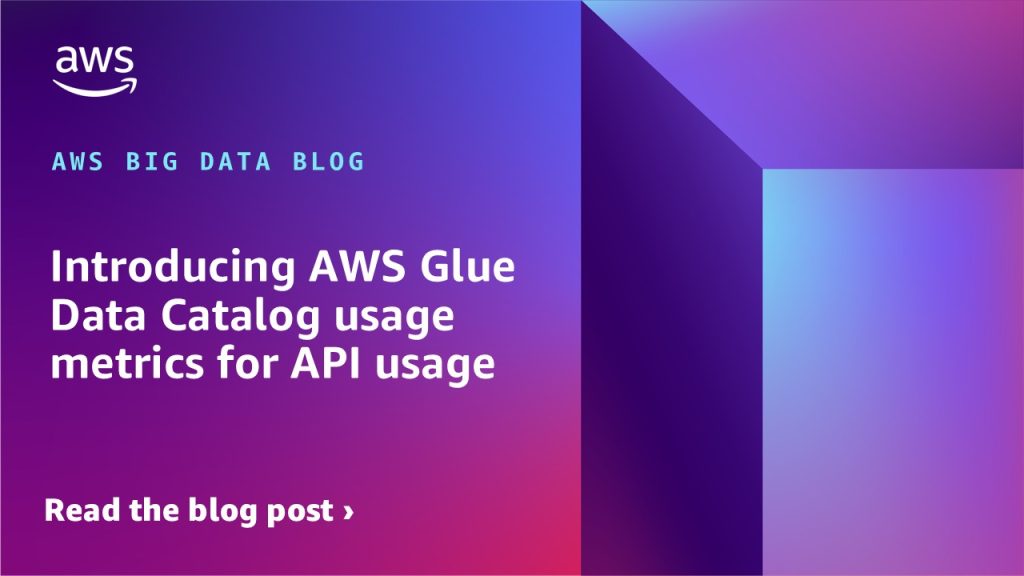AWS Big Data Blog
Category: AWS Glue
Enforce table level access control on data lake tables using AWS Glue 5.0 with AWS Lake Formation
In this post, we show you how to enforce FTA control on AWS Glue 5.0 through Lake Formation permissions.
Introducing AWS Glue Data Catalog usage metrics for API usage
We’re excited to announce AWS Glue Data Catalog usage metrics. The usage metrics is a new feature that provides native integration with Amazon CloudWatch. In this post, we demonstrate how to access these metrics, provide a step-by-step walkthrough, and set up meaningful alarms.
RocksDB 101: Optimizing stateful streaming in Apache Spark with Amazon EMR and AWS Glue
This post explores RocksDB’s key features and demonstrates its implementation using Spark on Amazon EMR and AWS Glue, providing you with the knowledge you need to scale your real-time data processing capabilities.
Simplify real-time analytics with zero-ETL from Amazon DynamoDB to Amazon SageMaker Lakehouse
At AWS re:Invent 2024, we introduced a no code zero-ETL integration between Amazon DynamoDB and Amazon SageMaker Lakehouse, simplifying how organizations handle data analytics and AI workflows. In this post, we share how to set up this zero-ETL integration from DynamoDB to your SageMaker Lakehouse environment.
Using AWS Glue Data Catalog views with Apache Spark in EMR Serverless and Glue 5.0
In this post, we guide you through the process of creating a Data Catalog view using EMR Serverless, adding the SQL dialect to the view for Athena, sharing it with another account using LF-Tags, and then querying the view in the recipient account using a separate EMR Serverless workspace and AWS Glue 5.0 Spark job and Athena. This demonstration showcases the versatility and cross-account capabilities of Data Catalog views and access through various AWS analytics services.
Access Amazon Redshift Managed Storage tables through Apache Spark on AWS Glue and Amazon EMR using Amazon SageMaker Lakehouse
With SageMaker Lakehouse, you can access tables stored in Amazon Redshift managed storage (RMS) through Iceberg APIs, using the Iceberg REST catalog backed by AWS Glue Data Catalog. This post describes how to integrate data on RMS tables through Apache Spark using SageMaker Unified Studio, Amazon EMR 7.5.0 and higher, and AWS Glue 5.0.
Configure cross-account access of Amazon SageMaker Lakehouse multi-catalog tables using AWS Glue 5.0 Spark
In this post, we show you how to share an Amazon Redshift table and Amazon S3 based Iceberg table from the account that owns the data to another account that consumes the data. In the recipient account, we run a join query on the shared data lake and data warehouse tables using Spark in AWS Glue 5.0. We walk you through the complete cross-account setup and provide the Spark configuration in a Python notebook.
Accelerate lightweight analytics using PyIceberg with AWS Lambda and an AWS Glue Iceberg REST endpoint
In this post, we demonstrate how PyIceberg, integrated with the AWS Glue Data Catalog and AWS Lambda, provides a lightweight approach to harness Iceberg’s powerful features through intuitive Python interfaces. We show how this integration enables teams to start working with Iceberg tables with minimal setup and infrastructure dependencies.
Melting the ice — How Natural Intelligence simplified a data lake migration to Apache Iceberg
Natural Intelligence (NI) is a world leader in multi-category marketplaces. In this blog post, NI shares their journey, the innovative solutions developed, and the key takeaways that can guide other organizations considering a similar path. This article details NI’s practical approach to this complex migration, focusing less on Apache Iceberg’s technical specifications, but rather on the real-world challenges and solutions encountered during the transition to Apache Iceberg, a challenge that many organizations are grappling with.
Amazon SageMaker Lakehouse now supports attribute-based access control
Amazon SageMaker Lakehouse now supports attribute-based access control (ABAC) with AWS Lake Formation, using AWS Identity and Access Management (IAM) principals and session tags to simplify data access, grant creation, and maintenance. In this post, we demonstrate how to get started with SageMaker Lakehouse with ABAC.









